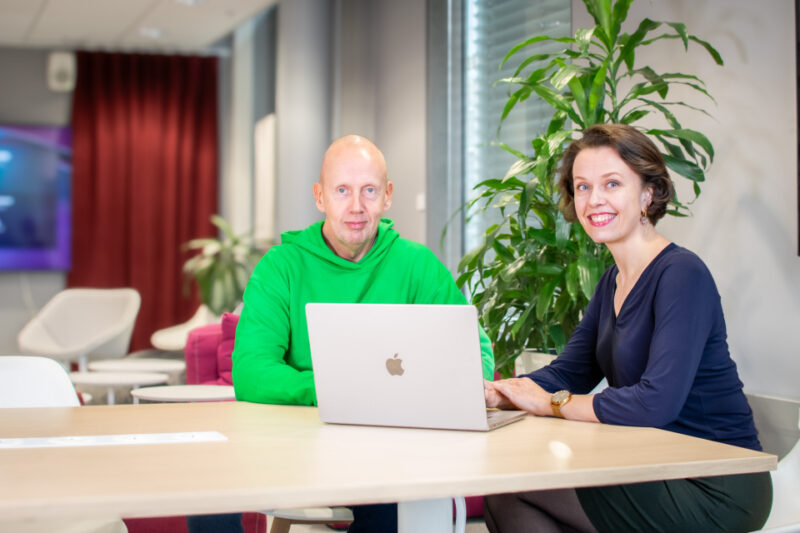Leading the way in digital public services
Digital government services can save taxpayers both time and money, while also promoting equality across society. However, this requires a shift in focus from developing individual services to creating integrated service ecosystems based on people’s needs, Tiina Rikka and Marko Saarinen remind us.
Many still remember what completing a tax return was like twenty years ago. Every source of taxable income and deduction had to be entered manually on a paper form. You needed to keep hold of your payslip from your employer, any receipts for additional income, and a pile of papers proving deductible expenses.
This paperwork usually consumed an entire evening, often several. Eventually, the tax return and the bundle of documents were stuffed into an envelope and posted. Then came the long wait – over half a year – for the tax decision and the news of whether you would receive a refund or have additional tax to pay.
Nowadays, most of us complete our tax return in the online OmaVero service, based on a pre-filled proposal. The process takes just a fraction of the time it used to, and you get a fairly accurate estimate straight away of whether you will receive a refund or owe back taxes.
One-Stop shop
OmaVero is an excellent example of a well-functioning digital public service. It also provides valuable lessons for developers of other state and municipal e-services.
What makes it user-friendly is the “one-stop shop” principle – the ability to handle everything you need in one place. Self-service is made easy through digitalised processes such as automatic calculations and intelligent forms. The service proactively guides users with reminders, and self-service is seamlessly integrated with customer support: help is available via chat or phone whenever needed.
Transparency is also key. Allowing taxpayers to see all their personal information and ongoing processes builds trust in the tax authority’s operations.
From the authorities’ perspective, the seamless integration of the service ecosystem is just as important. The systems behind the service are successfully interconnected, and data flows freely between them. For a platform serving millions of Finns, scalability and the ability to handle large volumes simultaneously are also essential.
The core of developing digital public services lies in improving both the customer experience and operational impact through more efficient e-services and customer support – while simultaneously reducing costs by moving interactions to more cost-effective digital channels.
From digitising papers to need-based services
Finns are a digitally skilled people. Over 80% have both the willingness and the ability to use digital services. Finland also stands out internationally as a society built on exceptional levels of trust, a society where people trust each other and their authorities. All this gives Finland an excellent opportunity to become a global leader in digital public services. For public administration, this creates a strong mandate to invest in digital solutions.
There is still plenty to do, however, as not all digital services are as user-friendly as OmaVero. The “one-stop shop” model and proactive guidance are often still more an ambition than a reality. Many public services remain untouched by digitalisation altogether.
But this is not about simply converting paper forms into online templates. Instead of developing isolated services for individual administrative tasks, digitalisation allows a rethinking of how public services can best support citizens in various life situations, thus making society as a whole function more smoothly. People could be supported more effectively, above all, by automating services based on different needs and life circumstances.
A new approach to service design
Consider one of life’s most difficult moments: the death of a loved one. Today, a grieving relative must deal with multiple authorities and services regarding inheritance, wills, estates, and burial arrangements. This burden could be eased if the person didn’t have to search for information and navigate the system alone. A digital public service could instead recognise the citizen’s life situation and automatically guide them through the entire process they need.
Needs-based thinking brings with it many advantages. By bringing services closer to citizens, it promotes equality and improves the impact of public administration, thereby strengthening societal trust. At the same time, it enables public resources to be used more efficiently.
However, needs-based service design requires a new mindset among authorities, one that crosses departmental and organisational boundaries and encourages open collaboration between the public sector and private service providers. Effective automation relies above all on the ability of different services to communicate with one another and share data seamlessly.
Public administration can often benefit from building services on existing business platforms, as these offer a secure, modern, and data-driven foundation for customer and transaction services. A hybrid model can also work well, for example, using a business platform as the backbone for customer service, integrated with national identification solutions and agency-specific back-end systems.
Automation that frees people to be human
Automation is not an end in itself, not even in public services. The focus of needs- and life-situation-based development should be on automating routine tasks and decisions, as well as the preparatory work for decisions made by human officials.
This allows experts in public administration to concentrate on their core duties and on situations that require human interaction and empathy. In all likelihood, this will improve not only the quality of service for citizens but also job satisfaction among public-sector professionals.
By creating services that are smarter in identifying people’s needs, easier to use, and written in plain language, the proportion of Finns using digital services will undoubtedly continue to grow. It will never reach 100%, however, as there will always be people who need personal assistance, for example, due to advanced age or health-related limitations. One goal of automation should therefore be to free up resources so that officials can provide more personal service to those who need it most.
Making Finland a pioneer in digital public services will not only save taxpayers time and money. It will also enable the country to offer its citizens better, fairer, and more human-centred services.

About the authors:
Tiina Rikka
Director, Public Sector Services, Sofigate
Tiina Rikka leads Sofigate’s Public Sector Services. She is a passionate reformer of digital public services who believes that technology, people, and data can be combined in ways that genuinely make everyday life better. Tiina has been closely involved in numerous public sector projects that go beyond simply digitalising the past, building instead the bold, future-ready services of tomorrow.
Marko Saarinen
Head of CX and Salesforce Business, Sofigate Finland
Marko Saarinen is responsible for Sofigate’s CX and Salesforce expert services and business in Finland. He is an expert in data-driven customer engagement and digital services. Marko’s passion lies in helping organisations operate more efficiently and effectively, and in creating exceptional service experiences by making the most of what digital channels and customer data have to offer.
Want to learn more?
We’re glad to tell you how we can help your organisation grow and develop – feel free to contact us!


